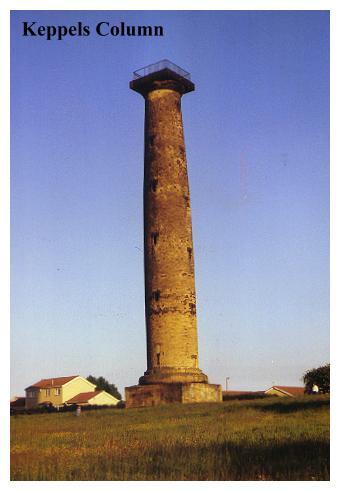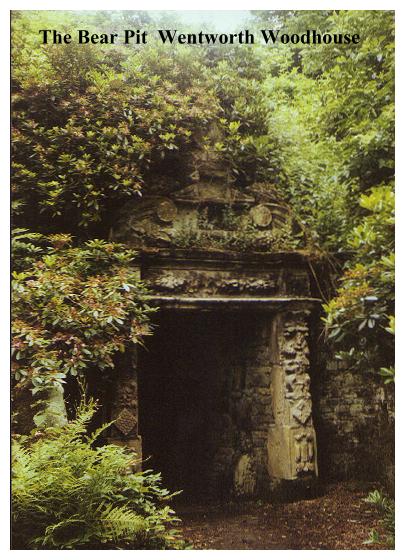
Two interesting churches, a beheaded earl, a displaced chinaman, a grotto in lovely gardens, woods, lakes, cornfields and a monument to a disgraced admiral are all to be found on this, our second visit to the follies of Wentworth Woodhouse. Two playgrounds, along with lots of woodlands and open spaces make this a walk worth taking the kids on, but don't work them too hard.... this is a 'fair ramble'.
Getting there : Leave M1 at junction 36. Follow A6135 through Hoyland Common and beyond Tankersley Park turn L onto lane to to Wentworth. Park in village carpark by play area and cricket ground. (Parking is also available at the garden centre, but the gates are locked when the centre closes).
Distance: 6 Miles approx.
Map ref: Sheet 102 Huddersfield (1" series) SK 388 982
Rating: Follies & General Interest *** Walk ***
So here we are again back in the village of Wentworth as promised! Our previous walk skirted the edge of Wentworth on the way back to Elsecar, but on this occasion we have time to explore the village at our leisure.
Turning right out of the carpark by Wentworth Cricket Club we proceed along the main village street towards that hub of all rural communities- the church or in this case the churches; for Wentworth has two:- one grand and victorian and the other small and ruined. The Old Church is now disused. A notice informs us that 'This ancient church is maintained by the Redundant Churches Fund'. The nave has gone and the tower is ruinous but the mediaeval chancel and north chapel remain as the Wentworth Chapel. Externally the structure is predominently 17th century, but still retains vestiges the earlier church. Stone bought by Thomas Wentworth from the sale of Monk Bretton Priory after the Dissolution is said to be incorporated into the fabric of the building.
The main attraction of the old church is its monuments. Keys can be obtained for closer inspection if required, but much can be seen by simply looking through the window. One alabaster monument to the Gascoyne family dates from 1460, but by far the most striking is the colourful monument to Sir William Wentworth with its kneeling figures, dating from 1612. Next door to it, kneeling in a niche in the wall is the somewhat flamboyant effigy of Thomas Wentworth, the first Earl of Strafford. The inscription reads:-
Thomas Wentworth
Earl of Strafforde,Visfcount Wentworth,
Baron Wentworth of Wentworth Woodhouse
Neromarsh Oversley and Raby .
Lord Lieutenant of Ireland, Lord President of the North of England
and Knight of the most noble Order of the Garter.
His birth was upon Good Friday the 13th April 15 his death
upon the 12th of May 1641. His soule through the mercy
of God lives in eternal bliffe and his memory shall
never die in these Kingdomes.
The monument tactfully makes no mention of the fact that Wentworth's demise was occasioned by the fall of the headsman's axe, for here,in this tiny Yorkshire church, repose (so we are told!) the mortal remains of one who played out a tragic role on the fateful stage of Stuart history! The story of Wentworth's rise and subsequent fall from grace is reminiscent of the classical tragedy of Sejanus. Overly privileged and high handed- yes, lining his pockets- possibly, but Strafford was in no way guilty of the charge of high treason which was levelled at him by a spiteful and venomous Parliament which howled for his blood. Lodged in the Tower and subsequently tried before the Lords, Strafford fought desperately for his life, and put up such a noble defence that he emerged guiltless. It did not save him. Thwarted, Pym and the Commons resorted to less noble means, a tyrannous Act of Attainder, which only needed the threat of war and insurrection to force a reluctant Charles I to sign his trusted servant's death warrant. Anxious for the safety of his threatened queen and hoping to win peace for his troubled kingdom Charles gave assent to the Act (Strafford having bravely written a letter releasing the king from his promise to protect his life and fortune). Charles never forgave himself. His most trusted advisor went to the scaffold and the stage was set for the final act of the tragedy that led to Civil War and Charles's own eventual appointment with the headsman.
Thomas Wentworth came from an influential family. (He took the title of Strafford, incidentally, from the name of the local wapentake). Thomas's father, Sir William, was Sheriff of Yorkshire 1601-2 and was created Baronet in 1611. With an estate worth £6000 per annum he was the wealthiest gentleman in Yorkshire. Strafford lived in no meaner style. It is recorded that his grand household at Wentworth Woodhouse consisted of 64 persons, 49 of them servants.
In the churchyard there are monuments to less illustrious but no less interesting denizens of bygone Wentworth. The Northern section of the churchyard is dominated by the massive Fitzwilliam Vault, and to the east of the main path is a gravestone bearing the following curious inscription:-
Therein lies a tale! Chow Kwang Tseay came to live in Wentworth when he was 10 years old. His origins are obscure. Certainly he was taken from Ningpo on a British warship bound for India, but how he came to be on the ship is uncertain. Was he sold by his parents? kidnapped? A Cabin Boy? A stowaway? We can only speculate. The boy was befriended by a merchant by the name of Captain Forster, who appears to have originated from the Wentworth area, and it was to him that 'Little Chopsticks' owed his subsequent good fortune.
The 5th Earl Fitzwilliam was apparently persuaded by Forster to undertake the care and education of the boy, and he was duly placed in the Ashcroft Academy under the tuition of Mr. William Beardsall. When he was baptized at Wentworth he adopted the name John Dennis Blonde, taking his surname from the Warship on which he had sailed:- HMS Blondi. At the Academy Chow Kwang Tseay began to grow into a young man, but the vexing question of his future employment was suddenly and tragically resolved by his untimely death at the age of 17. He was given a good 'send off' locally and here he now slumbers, far from his native land.
A short walk from the Old Church is the New. Holy Trinity was built 1875-7 and designed by J.L.Pearson. It is a magnificent 13th century style Gothic church with transepts, a tall spire and graceful lines. This is the soaring, solid church of the Victorian Fitzwilliams.
From the church a tree lined avenue leads towards Wentworth Woodhouse Park, passing behind the village to an iron gate. Cross the road to the Wentworth Garden Centre, and bear left, passing a landscaped carpark, craft shops and children's adventure playground. A right turn leads past the tree nursery into a restored 19th century Japanese ornamental garden with ponds, stepping stones, decaying statues, and most interestingly of all, our first folly, The Bear Pit.
The entrances to The Bear Pit are essentially fragments of the original 17th century house of the Earl of Strafford grafted onto an 18th century grotto. A short tunnel leads into a room with barred niches where the bears were (allegedly!) kept. A spiral stair with iron railings leads up to a terrace behind the garden. One can easily imagine the faltering steps of the gentlemen and the nervous giggles of the ladies who first ventured into this arcadian catacomb to the urgings of their host. The entrances, however, offer the most fascination, belonging as they do to an earlier period. The style is mannerist, circa 1630, being decorated with volutes, festoons and shields. One can only guess at the appearance of the fine house to which they once belonged.
Retrace your steps through the garden centre to the road,turn left, and follow it for some distance until a lodge house with a fine classical portico appears on the left. Pass through a stile by the gate and follow a footpath diagonally across wheatfields, noting the fine rotunda with a statue in Wentworth Woodhouse Park on the left. On reaching a gate and stile at the woodland perimeter continue onwards along a narrow corridor between trees to arrive at another gate and stile by a track. Continue onwards across yet another arable field to a gate and an elegant bridge at the start of the first of Wentworth Woodhouse's ornamental lakes. Polluted water plunges over a sudsy weir. The Marquess would not have approved!. Beyond the bridge bear right then left, along the field edge by a plantation. Halfway along, pass through the trees by a ruin (overgrown!) beyond which an elusive stile gives access to the pasture. Ascend the pasture to a gate and pass alongside the field boundary, turning right beyond outbuildings to meet the metalled road by Red House Farm. On entering the lane turn left and follow it downhill as it meanders through the village of Scholes, passing the Bay Horse and Scholes Cricket Club on the left. Beyond Scholes, where the road veers sharply to the right up the hill, continue onwards into woodland. A short distance on and a path leads off to the right, crossing a small footbridge to emerge onto open common. From here a well defined footpath, occasionally criss crossed by drainage channels, leads up the hillside to Keppel's Column.

That master was John Carr, and his employer was the second Marquess of Rockingham, who in 1778 was obviously intent on matching the architectural paranoia of his predecessor, the first Marquess. Built to rival Hoober Stand on the hillside opposite, Keppel's Column was (ostensibly!) erected as a monument to Viscount Keppel, Ist Lord of the Admiralty during Rockingham's government ministry. Keppel seems hardly worthy of such a singular honour. The monument in fact commemorates his aquittal after being courtmartialled on charges of incompetence and 'scandalous haste in quitting the scene of a naval engagement' at the Battle of Ushant. Rockingham was Keppel's friend, and believed that Keppel was actually just a scapegoat for the misdemeanours of Tory politicians who had been embezzling funds intended for the upkeep of the Navy. Be this as it may, it is a lame excuse, if ever there was one, for building such a monument as this. One feels that it was more of a pretext than a justification. After all, in modern terms it would be rather like erecting a monument to the military acheivements of President Galtieri!
The base of the column is vandalised, which no doubt explains why the entrance has been walled up. This is a pity, as the thing you want to do most with such a structure is to admire the view from the top (which is, after all, the reason why it was built!). The Wainhouse Tower in Halifax and the Jubilee Tower in Huddersfield are kept locked, but are both open to the public on Bank Holiday Weekends, briefly becoming tourist attractions. The admission fee to these follies contributes towards keeping them in good repair, and it is sad that no such plans are envisaged for Keppel's Column and Hoober Stand, both of which are structures intended to draw the eye and excite interest. Wainhouse Tower sells badges and postcards for its living. The Wentworth Follies are left to decay and eventual oblivion. Surely these wondrous structures deserve better than this???
From Keppel's Column follow well the defined footpath back to Scholes Coppice. (Bell ground- all the woods around here were planted to obscure early mine workings).On reaching the woodland (and a labyrinth of paths!) bear left,following a well defined path along the edge of the coppice until another (equally) well defined route leads off to the right down the wood. At the far end of the plantation ignore the stile into the pasture and turn left, following a path which leads below the steep bank of an arable field. On reaching a small footbridge bear right to the edge of an another field and then follow a well defined path which leads across two arable fields before finally descending to the dam across Dog Kennel Pond. Cross the dam and follow the track up the hillside to join the 'Hoober Stand' route walked previously coming in from the right. Turn left up to the deer park and the magnificent Southern front of the Wentworth Woodhouse mansion. Pass to right of mansion and stable blocks and leave the park. On reaching the road cross to Clayfield Lane and continue onwards to the cricket field, passing The Round House on the right. Cross the playground & football field to the carpark.
In these days of country parks and rural attractions, the tourism potential of Wentworth Woodhouse is immense. The disappearance of the pit heads and muck stacks in the area has revealed a landscape of gentle beauty, which deserves to be better known. The facilities exist at Wentworth Woodhouse for a complete leisure complex. Swimming pool,halls of residence, playing fields,tennis courts and 'clubhouse' are already in situ. Add to them a magnificent stately home as an museum and art gallery, an 18th century stable block as a countryside centre,and you have the makings of a major tourist attraction. And perhaps one day when the walk guides lead their tourist parties to the outer fringes of the estate, they will have the chance to explore and be thrilled by the Wentworth Follies, restored to their pristine condition, and not be left to shake their heads sadly at the ruined vanities of a forgotten age.



